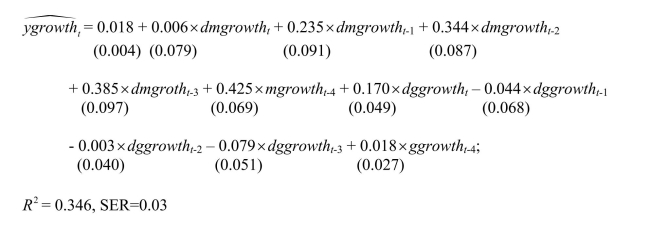A model that attracted quite a bit of interest in macroeconomics in the 1970s was the St.
Louis model.The underlying idea was to calculate fiscal and monetary impact and long
run cumulative dynamic multipliers, by relating output (growth)to government
expenditure (growth)and money supply (growth).The assumption was that both
government expenditures and the money supply were exogenous.Estimation of a St.
Louis type model using quarterly data from 1960:I-1995:IV results in the following
output (HAC standard errors in parenthesis):  where ygrowth is quarterly growth of real GDP, mgrowth is quarterly growth of real money supply (M2), and ggrowth is quarterly growth of real government expenditures. "d" in front of ggrowth and mgrowth indicates a change in the variable. (a)Assuming that money and government expenditures are exogenous, what do the
where ygrowth is quarterly growth of real GDP, mgrowth is quarterly growth of real money supply (M2), and ggrowth is quarterly growth of real government expenditures. "d" in front of ggrowth and mgrowth indicates a change in the variable. (a)Assuming that money and government expenditures are exogenous, what do the
coefficients represent? Calculate the h-period cumulative dynamic multipliers from these.
How can you test for the statistical significance of the cumulative dynamic multipliers
and the long-run cumulative dynamic multiplier?
Correct Answer:
Verified
View Answer
Unlock this answer now
Get Access to more Verified Answers free of charge
Q24: In the distributed lag model, the dynamic
Q25: Money supply is linked to the monetary
Q26: Your textbook mentions heteroskedasticity- and autocorrelation- consistent
Q29: To estimate dynamic causal effects, your textbook
Q32: Consider the following model
Q33: The distributed lag model relating orange
Q35: GLS is consistent and BLUE if
Q37: Your textbook presents as an example of
Q39: It has been argued that Canada's aggregate
Q40: One of the central predictions of
Unlock this Answer For Free Now!
View this answer and more for free by performing one of the following actions

Scan the QR code to install the App and get 2 free unlocks

Unlock quizzes for free by uploading documents